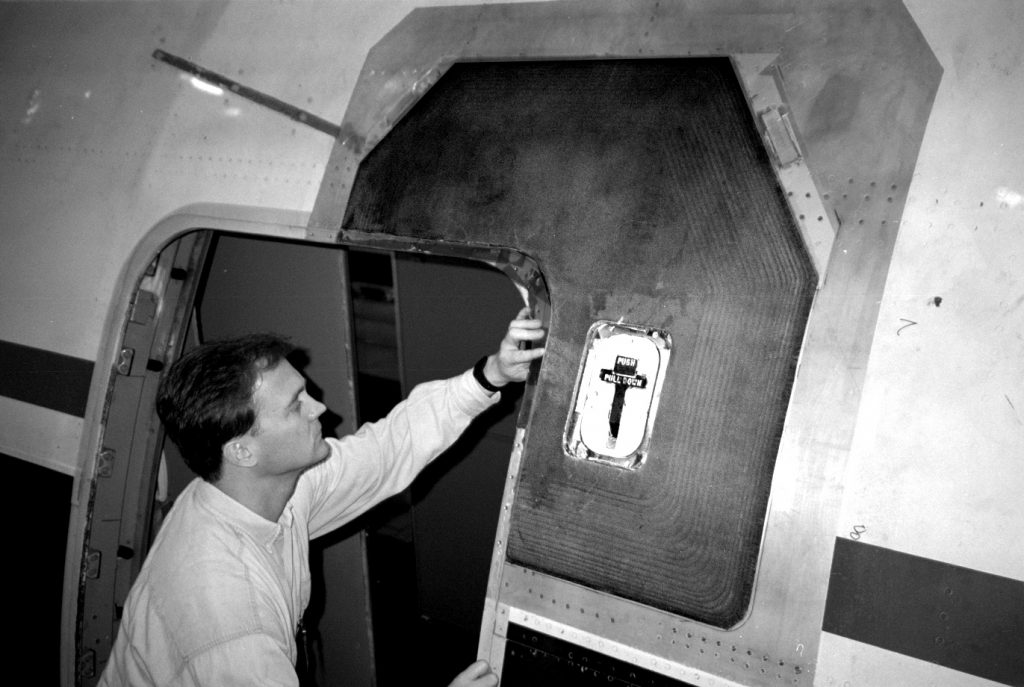
(Photo by Randy Montoya)
Download 150dpi JPEG image, ‘discov02.jpg’, 640K
ALBUQUERQUE, N.M. — The editors of Discover magazine have announced that two Sandia National Laboratories technologies are among 45 finalists now in the running for 1998 Discover Awards, issued each year by the magazine for the top inventions and engineering achievements of the preceding year.
Sandia’s new repair technique for commercial aircraft hulls and new memory-retentive computer chip will be recognized the evening of June 6 during an Academy-awards-style ceremony at Walt Disney World Resorts’ Epcot Center in Orlando, Fla.
One finalist in each of the nine categories will be selected to receive Discover Awards. Finalists and winners will be featured in the July issue of Discover.
The magazine announced the 45 finalists, chosen from nearly 4,000 invited entries, during National Science and Technology Week last week. The finalists, according to Discover’s editors, represent the technologies introduced in 1997 that promise to have the greatest impact on society and the world. The competition is informally dubbed the “Academy Awards of Innovation.”
“The Discover Awards for Technological Innovation honor the men and women whose creative genius improves the quality of our everyday lives and alerts us to what’s next from the frontiers of human achievement and ingenuity,” according to a Discover news release.
A panel of distinguished judges chose five finalists in each of the contest’s nine categories: transportation, aviation and aerospace, computer hardware and electronics, computer software, environment, sight, sound, emerging technology, and robotics.
Other Department of Energy laboratory finalist technologies include Oak Ridge National Lab (for its micromechanical infrared imager and its “Critters on a Chip” pollution detectors), Argonne National Lab (for its membrane filter for producing inexpensive biodegradable solvents and its friction-reducing film coating), and Pacific Northwest National Lab (for its technique for removing mercury from water supplies). Information about the two Sandia finalist technologies follow.
Commercial aircraft repair technique, aviation and aerospace category
A Sandia team demonstrated that a new type of aircraft fuselage “patch,” made of a synthetic boron fiber-epoxy material adhered to the aircraft’s hull, was stronger and easier to apply than traditional riveted metal patches.
The Sandia engineers, based at the Airworthiness Assurance NDI Validation Center (AANC) managed and staffed by Sandia for the Federal Aviation Administration (FAA), first installed the new type of lightweight patch in February 1997 to reinforce a door corner on an active Delta Airlines L-1011 passenger jet following an intensive validation and flight-certification procedure with the FAA. Several successful inspections of the patch’s integrity have occurred since the installation, and scientists at the AANC and FAA are working to certify the bonded composite doubler technique for a variety of other common aircraft repairs.
Wide application of the technique could save the airlines industry millions of dollars and safely extend the lives of hundreds of aging commercial airliners.
The work was a collaboration among Sandia, Delta Airlines, the FAA, Textron Systems Division, and Lockheed Martin Corp. More information about the project is available at https://newsreleases.sandia.gov/new-aircraft-repair-technique-receives-faa-certification-delta-l-1011-returned-to-trans-atlantic-service/.
Memory-retentive computer chip, computer hardware and electronics category
Scientists at Sandia and France Telecom have developed an inexpensive, low-powered memory-retention device that may keep computer data from being lost during a power outage.
To create the new type of chip, the scientists bathed the device in hydrogen gas at a key step during fabrication. The gas permeates the heated chip, and protons become embedded at defects in the silicon dioxide. During operation, the protons can roam only within the chip’s central layer of silicon dioxide, which is sandwiched between layers of silicon. When the power is turned off, the protons stay where they are, thus preserving the information. In devices such as D-RAMs (dynamic random access memory), typically based on electron flow, all data are lost when the power goes off.
The technique is simple and inexpensive and requires only a few additional processing steps.
The work is a collaboration between Sandia and France Telecom. More information about the project is available at https://newsreleases.sandia.gov/protonic-computer-memory-remembers-information-when-power-goes-off/.
Ninth year of awards competition
In 1997 Sandian Ralph James at Sandia’s California site was a Discover Award winner in the “sight” category for his wristwatch-sized detector that can distinguish between sources of radiation.
Judges for the 1998 Discover Awards competition include celebrities, professors, astronauts, scientists, executives of major corporations, and public officials.
This is the ninth year Discover has honored top innovators. The general-audience science magazine has a circulation of 1.2 million.
More information about the Discover Awards for Technological Innovation are available at http://www.discover.com/awards